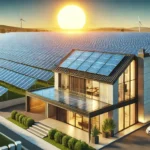As the global demand for renewable energy intensifies, innovative solutions like floating solar farms—also known as floatovoltaics—are emerging as efficient alternatives to traditional land-based solar systems. These installations involve mounting photovoltaic panels on bodies of water, offering unique advantages that address both energy production and environmental conservation.
Advantages of Floating Solar Farms
1. Land Conservation
By utilizing water surfaces such as reservoirs, lakes, and ponds, floating solar farms preserve valuable land resources. This approach is particularly beneficial in densely populated regions where land availability is limited.
2. Enhanced Efficiency
The natural cooling effect of water bodies can improve the performance of solar panels. Studies have shown that floating solar installations can achieve energy gains ranging from 5% to 15% compared to their land-based counterparts.
3. Water Conservation
Covering water surfaces with solar panels reduces evaporation, a significant advantage in arid regions. For instance, implementing floating solar on Lake Nasser in Egypt could potentially save up to 9.07 billion cubic meters of water annually. mdpi.com
4. Environmental Benefits
Floating solar installations can mitigate algal blooms by limiting sunlight penetration into the water, thereby improving water quality. Additionally, these systems can coexist with existing water uses, such as irrigation and fishing, without significant disruption.
Global Adoption and Notable Projects
The adoption of floating solar technology has accelerated in recent years. Global installed capacity grew from 3 GW in 2020 to 13 GW in 2022, surpassing earlier projections. mdpi.com
Japan
Japan has been a pioneer in floating solar technology, with numerous installations across the country. These projects demonstrate the feasibility and benefits of utilizing water surfaces for renewable energy generation.
India
In India, floating solar farms have been deployed to address land scarcity and water conservation needs. These installations contribute to the country’s renewable energy targets while preserving agricultural land.
United States
The U.S. has significant potential for floating solar, with suitable bodies of water well-distributed across the country. Implementing floating solar on these water bodies could substantially boost renewable energy generation.
Challenges and Future Prospects
Despite the advantages, floating solar farms face challenges, including higher initial costs—approximately 10-25% more than land-based systems—due to the need for specialized anchoring and mooring systems. However, as technology advances and economies of scale are realized, these costs are expected to decrease.
Environmental considerations, such as impacts on aquatic ecosystems and water quality, require careful assessment and management. Ongoing research aims to optimize floating solar designs to minimize ecological disruptions.
The future of floating solar farms is promising, with projections indicating continued growth. Innovations in materials, such as the development of flexible and lightweight solar panels, are expected to enhance the efficiency and adaptability of floating solar installations. mdpi.com
Conclusion
Floating solar farms represent a significant advancement in renewable energy technology, offering efficient and sustainable solutions for solar power generation. By addressing land scarcity, enhancing panel efficiency, conserving water, and providing environmental benefits, floatovoltaics are poised to play a crucial role in the global transition to clean energy.








